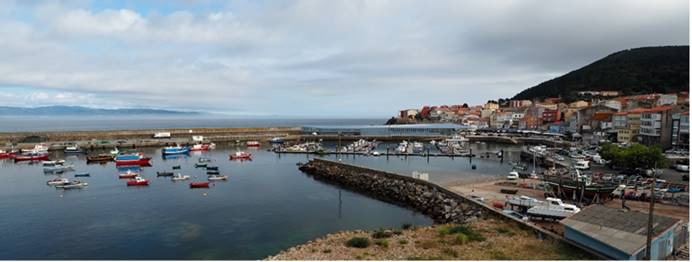11 July - a short stop at the end of the world

42:45.525N 009:03.97W The plan for Sunday in Camarinas was to hire bikes and make our way along the coastal paths to the English Cemetery at Cabo Vilan, a treacherous bit of the Costa da Morte where HMS SERPENT went down in 1890. A classic combination of poor ship design and navigational errors, she was an Archer Class Torpedo Cruiser returning from Ghana to Devonport that had engineering difficulties in bad weather too close to land… 173 men perished and many were buried by the locals at this spot. The people here make an annual visit to the graves and the site is very much part of the local maritime fabric. It reminds me that mariners of all nations have more in common with each other than their politics and governments might suggest.
Camarinas So, bikes were booked on Saturday afternoon and we turned up as the tourist office, which owned the only two hire bikes in town, opened. We were issued with brand new crash helmets straight out of the box, handed over some shekels and got… 5 yards. Julie’s bike was making a strange noise. A short inspection revealed a three-inch tear in the rear tyre. It must have been there for some time and clearly the demand for bike hire is on a par with the lapsed laundry service in Camarinas. So we returned to the boat and took advantage of the overcast, windless weather to push on round Cabo Finisterre.
The lighthouse at Cape Finisterre The fishing village of Fisterra (Galician, I think) is the most picturesque we have come across so far. For whatever reason, the urge to tear down the traditional buildings and replace them with apartment blocks is less prevalent here, certainly around the harbour itself. The fishing fleet is big, almost as big as the splendid modern building that houses their market AND the tourist office! Interestingly, Finisterre is the last stop on the Camino Santiago. Once you have paid your respects to St James in Santiago de Compostela, you travel to the end of the world to look out into the unknown… So apart from fishing, tourism is also big business here – albeit at the budget end of the market.
Fisterra This particular section of the Camino is the only one that starts in Compostela and it pre-dates Christianity. The Pagans believed that it was where the sun died and the worlds of the living and the dead met. Certainly the sun wasn’t out when we walked the couple of miles from the village to the lighthouse, but by early afternoon it did manage to burn off the persistent cloud to give us a glimpse of the way to America…
The end of the road… or the start? On our return to the boat, we met a rather unusual member of the marine community – an otter. He had swum right across the harbour, came alongside us for a good look and then pottered off towards the nearby shoreline. I don’t think I’ve ever seen one in the wild before – and here, in the middle of quite a busy fishing harbour, he seemed both out of place and quite at home. Quite a big fellow, judging by the photos we found on the Interweb.
Orlando the Otter Taking his visit as a good omen and with a pleasant north westerly breeze blowing, we left Fisterra and set sail (genoa only) for the Ria de Muros, some 15 miles south. I ran the generator for a couple of hours, producing 120 litres of fresh water and heating some of it for showers, whilst charging the batteries. Some interesting statistics emerged: since we last topped up fuel and water ashore a fortnight ago, we now have 75% fuel and 85% water still in the tanks – despite motoring for much of our time underway and only making water when the depth exceeds 30m. The scenery along this stretch of coast is impressive: some rashes of angry rocks lie a mile or so offshore guarding the coast from the unwary, sandy beaches run along most of the shore with dunes behind, rising quickly to rocky hillsides with scattered pine trees and the odd smallholding indicating the presence of man. As we turned to enter the Ria, we were met by a fleet of around ten 25m offshore fishing vessels, all engaged in purse seine fishing. You don’t see much of this in the English Channel and it’s impressive: they lay a net in a circle about 200m across at high speed and then haul the two ends together, trapping anything not quick enough to see the threat and escape. Aggressive boat handling and good seamanship are the order of the day and we enjoyed watching them at close range.
Setting the nets We anchored in the Ensenada de san Francisco, just 100 yards off the beach where there is a promising looking restaurant to be inspected tomorrow… |





